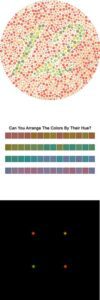Colour Blindness
Colour blindness affects about 1 in 20 men and 1 in 200 women in the UK.
What is colour blindness?
Colour blindness – more correctly referred to as “colour vision deficiency” – is a very variable condition. Individual sufferers have difficulty recognising different sets of colours on the spectrum. And the severity ranges from experiencing only slight differences in your appreciation of various hues to almost total inability to differentiate colours.
How do you test for colour blindness?
In the UK, you can test for colour blindness by visiting an optician and asking for a colour vision test. Some common tests include:

-
Ishihara test – A test that uses coloured plates with circles of dots in different colours and sizes.
-
Colour arrangement test – A test where the test taker is asked to arrange coloured objects in order of shade.
-
Lantern test – A test used to identify people who are not suitable for certain jobs, such as train driver, marine, or aviation.
Colour vision tests are not usually part of a routine health service test. However, you can ask for one if you think you or your child may have a colour vision deficiency, especially if it started suddenly or is getting worse.
Who does this affect?
This condition occurs more often in men, affecting around 1 in 20 in the UK. It is much less common in women, affecting only 1 in 200. Total colour blindness (i.e., seeing only shades of grey), however, is extremely rare.
People are not always aware that they suffer from a mild colour vision deficiency. We strongly recommend having your eyes tested by your optician at least every 2 years. If you have any concerns about your colour perception, make sure you ask for an eye examination that includes a test for colour vision.
What are the treatments?
There is no treatment for this. Sufferers generally have to adapt to the condition.
Useful Links